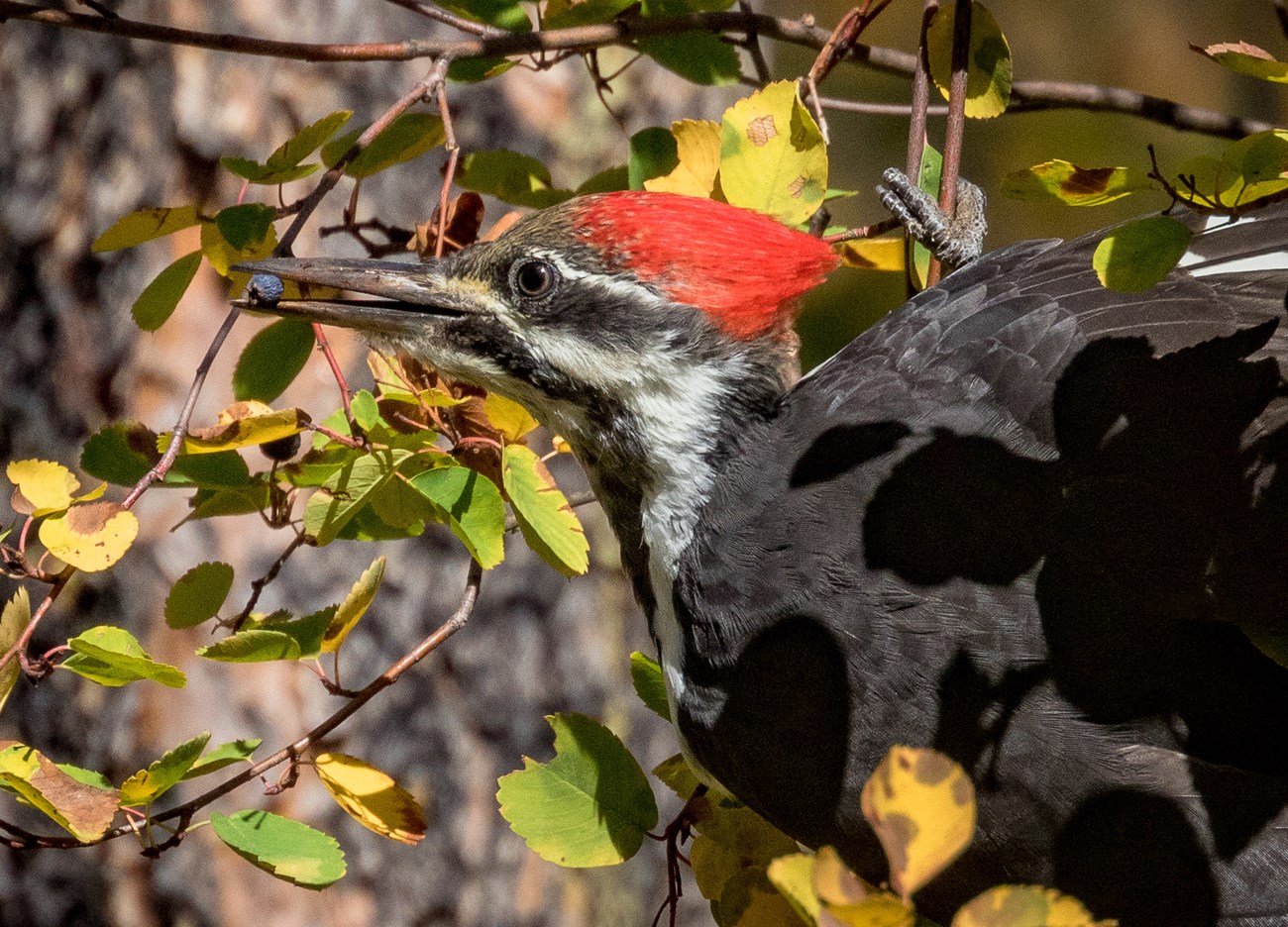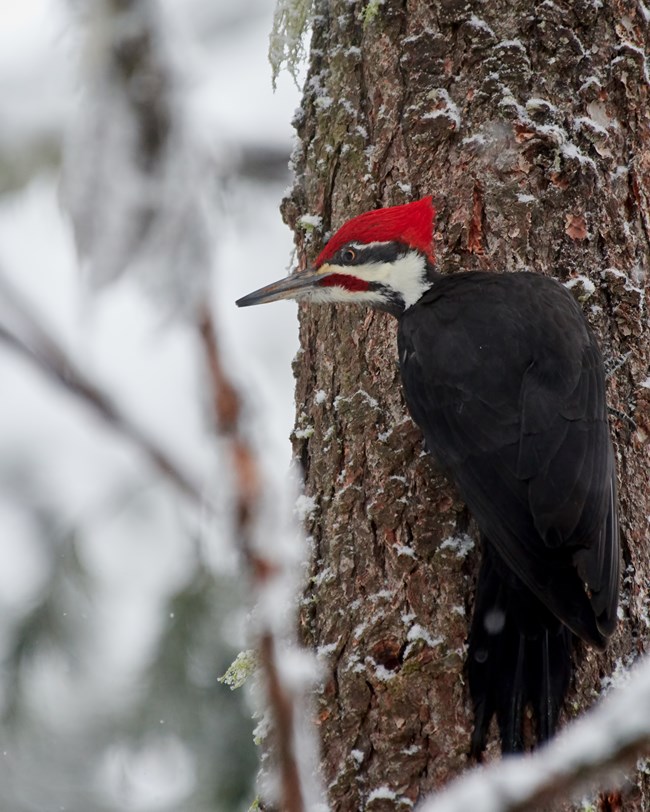Last updated: April 28, 2021
Article
Pileated Woodpecker

© Nick Viani

© Frank Lospalluto
General Description
For the largest woodpecker in the country, the pileated woodpecker is surprisingly hard to see. You’re more likely to hear its drumming or high-pitched, piercing alarm call drifting through the forest.
Dryocopus pileatus is a crow-sized (40–49 cm long, (15–19 in)) member of the woodpecker family, Picidae. Perched, it appears almost all black except for a black-, white- and red-striped head with a pointed red crest. In flight, large, white underwing patches show. Males are slightly larger than females and are distinguished by a red malar (“mustache”) stripe and solid red from the crest to the beak. Females lack the red malar stripe and have a small yellowish-brown patch on their foreheads in front of the red crest. Like most woodpeckers, its toes are arranged in a zygodactyl pattern—2 forward and 2 back—to better grasp and climb on trees.
Habitat and Range
Death and decay mean survival for pileated woodpeckers. Snags, logs, and weakened live trees provide the soft wood inhabited by carpenter ants, a favorite food. Pileated woodpeckers also need trees big enough to contain the large nest cavities they excavate. Old-growth forest meets these habitat needs, and Douglas-fir, especially in western Oregon, is a choice nest and roost tree.
Pileated woodpeckers occupy relatively large territories (>1000 acres in the West) year-round. They range from northern California up into Canada and back down into much of the eastern U.S., wherever big trees and decaying wood are found.
Diet and Behavior
With their stout, chisel-like beaks, pileated woodpeckers dig for ants and wood-boring beetle larvae deeper than most other woodpeckers can reach, past the tree’s cambium (thin layer of living, growing tissue). They also glean (pick) insects off branches and scale bark off trees in search of food. Fruit from serviceberry and Oregon grape is sometimes on the menu, as well as nuts. Like many woodpeckers, their long retractable tongues have barbs and sticky saliva to snare bugs.
Pileated woodpeckers give a variety of calls, from soft chucks to a louder, repeated, “cuk, cuk, cuk.” These calls, along with drumming against the resonant trunk of a dead tree, are often tied to courtship or territoriality.
Have you ever wondered how woodpeckers avoid brain damage, striking at wood up to 12,000 times a day? Sponge-like rear skull bones, along with a well-cushioned brain cavity and minimal cerebrospinal fluid (less sloshing around) help absorb the impact.
Reproduction
Pairs mate for life and produce one summer brood. Courtship begins in early spring with head swinging, drumming, wing spreading displays, and crest raising. Both sexes help build a new nest cavity each year, typically in a dead or decaying tree. The opening averages 9 cm (3.5 in) wide, though it can be larger, and may reach 66 cm (24 in) deep. If you come across a relatively large, rectangular shaped opening in a decaying tree, with lots of fresh wood chips below it, you may have just stumbled upon a nest cavity.
After laying an average of four white, oval eggs, the female shares incubation duties with the male. In 15 to 18 days, the eggs hatch into naked and helpless (altricial) young that are fed regurgitated insects. By 2 to 3 weeks, nestlings “cuk” from within the nest. By 4 weeks, they fledge (mid-May to early July in California), but remain dependent on the adults for several more months.
Ecology
Thanks to pileated woodpeckers, many forest animals have a place to shelter overnight and nest! Secondary cavity nesters, like small owls, ducks, bats, and flying squirrels, who cannot build their own nests, rely on abandoned cavities excavated by primary cavity nesters, like the pileated woodpecker. Large cavity nesters, like fishers (large weasels), are especially dependent on spacious pileated nest holes. But that’s not all that makes this bird a keystone forest species. Its excavations also knock a vast amount of wood out of trees, speeding decomposition and nutrient cycling.
Conservation
While increased protection for decadent older forests has stabilized Pacific Northwest populations, Audubon climate change models project a northward shift for this species.
Where to Find
Though sometimes rare, pileated woodpeckers occur in all Klamath Network parks.
Learn More
Calls and drumming:
https://www.allaboutbirds.org/guide/Pileated_Woodpecker/sounds
Was Woody Woodpecker a pileated?
https://www.npr.org/templates/story/story.php?storyId=101665227
Download a pdf of this article.
Prepared by Sonya Daw
NPS Klamath Inventory & Monitoring Network
Southern Oregon University
1250 Siskiyou Blvd
Ashland, OR 97520
Featured Creature Edition: October 2019
